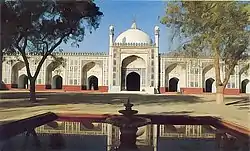Subah of Multan
The Subah of Multan or Multan Province was a subdivision of the Mughal Empire, one of the original twelve provinces of Mughals ,encompassing the southern Punjab region, stretching towards parts of Khyber, Central Punjab and Balochistan, bordering Kandahar Province and Persian Safavid Empire. It was one of the largest and important provinces of Mughal Empire.[1]
| Subah of Multan | |||||||||
|---|---|---|---|---|---|---|---|---|---|
| Subdivision of Mughal Empire | |||||||||
| 1580–1756 | |||||||||
 Alam flag of the Mughal Empire | |||||||||
 Multan Subah depicted in map of Mughal India by Robert Wilkinson (1805) | |||||||||
| Capital | Ferozepur | ||||||||
| History | |||||||||
| Historical era | Early modern period | ||||||||
• Established | 1580 | ||||||||
• Disestablished | 1756 | ||||||||
| |||||||||
| Today part of | |||||||||
Geography
The subah of Multan was bordered to the north by the Lahore Subah and Delhi Subah, to the west by the Safavid Empire, to the north-west by the Kabul Subah, to the east by the Ajmer Subah and Gujarat Subah and to the west by Thatta Subah.
History
The Subah of Multan was one of twelve administrative divisions created by the Mughal Emperor Akbar in 1580.[2] Ferozepur acted as the capital of the Multan subah according to the Ain-i-Akbari.[3]
Economy
Under Mughal rule, Multan enjoyed 200 years of peace in a time when the city became known as Dar al-Aman ("Abode of Peace"). During the Mughal era, Multan was an important centre of agricultural production and manufacturing of cotton textiles.[4] Multan was a centre for currency minting,[4] as well as tile-making during the Mughal era.[5]

Multan would remain an important trading centre until the city was ravaged by repeated invasions in the 18th and 19th centuries in the post-Mughal era.[6] Many of Multan's merchants then migrated to Shikarpur in Sindh,[6] and were found throughout Central Asia up until the 19th century.[6]
Multan was also host to the offices of many commercial enterprises during the Mughal era,[4] even in times when the Mughals were in control of the even more coveted city of Kandahar, given the unstable political situation resulting from frequent contestation of Kandadar with the Persian Safavid Empire.[4]
Notable governors
The following is a list of notable governors of Multan subah appointed by the central Mughal government.[2][7]
16th century
- Syed Hamid Bukhari
- Sadiq Khan
- Muhib Ali Khan
- Rustam Mirza
- Said Khan
17th century
- Asaf Khan
- Najabat Khan
- Qulij Khan
- Yusuf Khan
- Najabat Khan
- Qulij Khan
- Saeed Khan
- Murad Baksh
- Saeed Khan
- Aurangzeb
- Bahadur Khan Rohela
- Aurangzeb
- Dara Shikoh
See also
References
- Dasti, Humaira Faiz (1998). Multan, a Province of the Mughal Empire, 1525-1751. Royal Book. ISBN 978-969-407-226-5.
- Husain, Afzal (1970). "Provincial Governors Under Akbar (1580-1605)". Proceedings of the Indian History Congress. 32: 269–277. ISSN 2249-1937. JSTOR 44141074. Retrieved 1 August 2020 – via JSTOR.
- Bassi, Tripti (2021). A Study of the Sikh Kanya Mahavidyalaya: Education, Religion and Gender Issues. Singapore: Springer Nature. p. 42. ISBN 978-981-16-3219-8. OCLC 1259627824.
Historically, the city was founded by Firoz Shah Tughlaq III (1351-1388 A.D). It was earlier an important centre between Delhi and Lahore (Sharma, 1983: 17). Firoz Shah IIl constructed the Ferozepore fort around 1370 (GoP, 2000: 13). The Ain-i-Akbari also refers to 'Ferozepore' as the capital of Multan province.
- Oonk, Gijsbert (2007). Global Indian Diasporas: Exploring Trajectories of Migration and Theory. Amsterdam University Press. p. 294. ISBN 9789053560358.
- Chaudhry, Nazir Ahmad (2002). Multan Glimpses: With an Account of Siege and Surrender. Sang-e-Meel Publications. ISBN 9789693513516. Retrieved 9 September 2017.
- Levi, Scott (2016). "Caravans: Punjabi Khatri Merchants on the Silk Road". Penguin UK. Penguin UK. ISBN 9789351189169. Retrieved 12 April 2017.
- Ali, M. Athar (1970). "PROVINCIAL GOVERNORS UNDER SHAH JAHAN—AN ANALYSIS". Proceedings of the Indian History Congress. 32: 288–319. ISSN 2249-1937. JSTOR 44141077. Retrieved 1 August 2020 – via JSTOR.